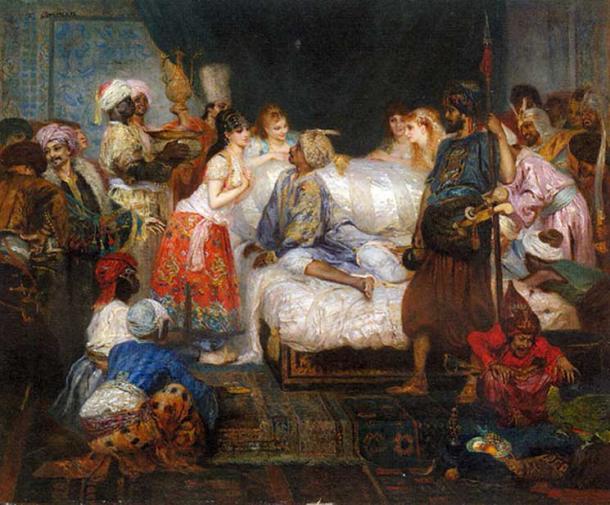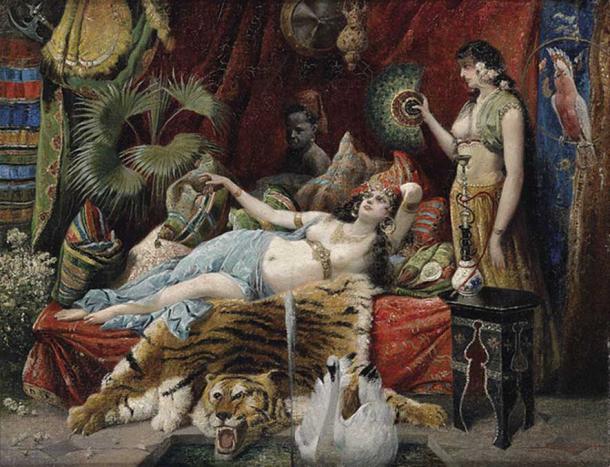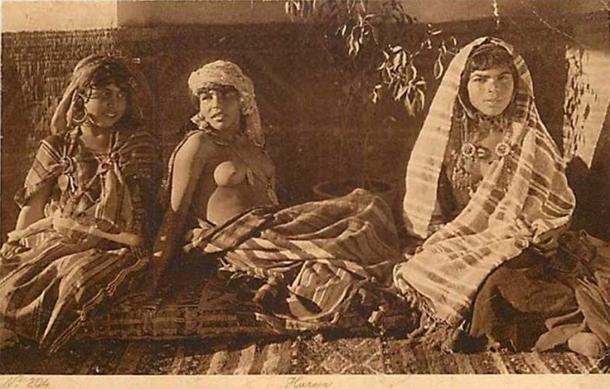The imperial harem of the Ottoman era was the collection of wives, servants, and concubines of the Sultan, who sometimes numbered in the hundreds. Some were mere playthings or used for the production of heirs, while others rose to great power and influence.
The term “harem” brings to mind an image of a room full of beautiful women whose sole purpose in life was to please their captor sexually. This image may have been inspired by the 16th and 17th century harems of the Ottoman Empire . However, the members of the harem were more than just sexual playthings for the Sultan.
Existing between 1299 and 1920 AD, the Ottoman sultan’s harem was comprised of wives, servants, female relatives of the sultan, and concubines. The women in the harem played a much greater role than simply entertaining the sultan, and some even had a hand in governing the powerful Ottoman empire. A period known as the “Reign of Women” or the Kadinlar Sultanati saw the harem of women playing an important role within the Ottoman government, leading them to gain more power than ever before.

Harem, Fernand Common ( Public Domain )
Large Harem, Great Power
The harem was the ultimate symbol of power and wealth of the Sultan. His ownership of women and eunuchs, mostly as slaves, showed his wealth and prowess. The institution of the harem was introduced in Turkish society with the adoption of Islam, under the influence of the Arab Caliphate, which the Ottoman’s sought to emulate.
Most of the men and women within the harem were bought as slaves to ensure obedience, however some remained free. The main wives, especially those married to solidify personal and dynastic alliances, were free women. Slaves and free men and women alike were given an education within the harem. At the end of their respective educations, the men and women would be married off to each other. Subsequently, the men would be sent to occupy administrative posts in the empire’s provinces.
Due to this practice, only a small number of women were chosen to become part of the Sultan’s personal harem of concubines. This group of women was governed by the Valide Sultan, typically the Sultan’s own mother.
An even smaller number of women would be chosen as the Sultan’s favorites, or the hasekis. Even these women could be chosen to be married off or sent as gifts to valued members of the Ottoman elite, that is if they hadn’t had sexual relations with the Sultan himself.

Dorotheum by Joseph Himmel, 1921. Shows the hierarchy within a harem ( Public Domain )
The First Lady of the Harem
The most powerful woman in the harem, the Valide Sultan , would have been a wife or concubine of the Sultan’s father and would have risen to supreme rank within the harem.
No court lady could leave or enter the premises of the harem without the permission of the Valide Sultan and the eunuchs of the court would answer directly to her. The Valide Sultan was also responsible for the education of her son on the intricacies of state politics. She was often asked to intervene on her son’s decisions as a member of the imperial court as well.
The next most powerful women in the harem would be the concubines that rose through the ranks to attain the titles of Gözde (the Favorite), Ikbal (the Fortunate) or Kadın (the Woman/Wife). Traditionally the Sultan could only have these four as his favorites and they had an equivalent rank to the Sultan’s legal wives within the hierarchy of the harem. They were given apartments within the palace, as well as servants and eunuchs.

Portrait of Emetullah Rabia Gülnuş Sultan, Valide Sultan of the Ottoman Empire, 1695-1715. She was the last imperial concubine to be legally married to an Ottoman Sultan. ( Public Domain )
The Reproductive Function of the Harem
Customarily, the harem of concubines, alongside legal wives, was used for the purpose of reproduction; it served to emphasize the patriarchal power of the Sultan. However, slave women, unlike the legitimate wives, had no recognized lineage.
Legal wives were feared to have a vested interest in the promotion of their own sons , leading to disloyalty to the Sultan. Therefore, concubines were more trustworthy when it came to producing sons, as they could have no interest in this promotion of their children, since it would have no effect on them as the mothers.
Through this practice, concubines were seen as a more legitimate source of sons as there was no opportunity for betrayal from the wives. While the concubines could gain favor with the sultan, they could never rise to power politically or gain legitimacy within the royal family.

Harem, Lehnert and Landrock Postcard ( Public Domain )
The Employment of Eunuchs
While these women played an important role within the harem they were only half of the equation. Eunuchs were the integral other half of the harem. Eunuchs were considered to be less than men due to the mutilation of their genitalia. As such, they were unable to be tempted by the women of the harem and therefore it was believed they would remain loyal to the Sultan and posed no threat to the sanctity of the harem.
Eunuchs tended to be slaves or prisoners of war that would have been castrated before puberty and condemned to a life of servitude. All eunuchs were castrated en route to the slave markets by their Christian or Jewish captors because Islam prohibited the practice of castration, but not the use of castrated slaves. Similarly, the female slaves of the harem would be mainly comprised of white Christian girls since Muslim women were forbidden from becoming concubines.

Guard of the Harem, Frank Duveneck, circa 1880 ( Public Domain )
There was a hierarchy of eunuchs within the harem, much like the hierarchy of women: the first were black eunuchs, or sandali, while the second and third tiers tended to be made up of white slaves and eunuchs. This distinction is directly linked to the level of mutilation of the men’s genitalia.
The first class of black eunuchs would have both penis and testicles removed, whereas the white slaves would be left with their testicles and a portion of their penis would be removed.
The black eunuchs, due to their lack of parts, were to serve in the harem and protect the women therein. These eunuchs would serve under the Kizlar Agha , or “chief black eunuch.” Conversely, the white eunuchs would be kept away from the women and assigned to roles within the government.
The Western View of the Harem
In the later history of the Ottoman Empire the harem became romanticized by the Christian west. In 1861, the French painter Henriette Browne, who had accompanied her husband on a diplomatic trip to Constantinople, caused a sensation when she exhibited one of her paintings in Paris that depicted the interior of the imperial harem.
Unlike our modern thoughts on harems , this painting depicted a rather tame scene of veiled, long-robed women chatting below a row of ornate arches, but this was considered the first eyewitness view of the inside of a harem by the west. Due to this sensation, the harem was seen as a tourist attraction until the Ottoman empire came to an end in 1920.
Top Image: The Harem Dance, Giulio Rosati. Source: Public Domain
Updated on January 7, 2021.
Related posts:
Views: 0
 RSS Feed
RSS Feed

















 January 8th, 2021
January 8th, 2021  Awake Goy
Awake Goy 





 Posted in
Posted in  Tags:
Tags: 
















